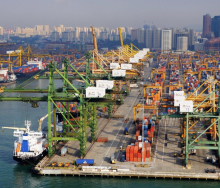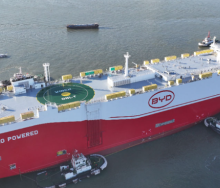Ocean freight container shipping spot rates are set to exceed the level seen at the height of the Red Sea crisis when the latest round of increases hit the market on June 1.
This is according to the latest data released by ocean and airfreight rate benchmarking and market analytics platform, Xeneta, on Thursday.
Xeneta chief analyst, Peter Sand, said the ocean freight container shipping market had seen “rapid and dramatic” increases during May, a trend that was set to continue, with further growth in spot rates.
“On June 1, spot rates will reach a level we haven’t seen since 2022 when the Covid-19 pandemic was still wreaking chaos across ocean freight supply chains,” Sand said.
“There is a cocktail of uncertainty and disruption across global ocean freight supply chains at present and this is fuelling the spot rate increases. However, it is the speed and magnitude of this recent spike that has taken the market by surprise, as well as the CEOs of the world’s biggest ocean freight liner companies,” he said.
From the Far East to US West Coast, market average spot rates are expected to reach $5 170 per FEU on June 1, which would surpass the Red Sea crisis peak of $4 820 seen on February 1. This is an increase of 57% during May and the highest spot rates have been on this trade for 640 days.
From the Far East to US East Coast, spot rates are expected to reach $6 250 per FEU, only slightly shy of the Red Sea crisis peak of $6 260 and an increase of 50% since April 29.
Spot rates are also set to exceed the Red Sea crisis peak on the Far East to North Europe trade, reaching $5 280 per FEU on June 1. This will be the highest rates have been on this trade for 596 days and an increase of 63% since April 29.
On the Far East to Mediterranean trade, spot rates are expected to edge past the Red Sea crisis peak of $5 985 per FEU on January 16 to reach $6 175 on June 1. This will be an increase of 46% during May and the highest rates have been on the trade for 610 days.
Factors fuelling ocean freight container spot rates spike
According to Xeneta’s data, the market is heavily impacted by a cocktail of factors including ongoing conflict in the Red Sea, port congestion and shippers deciding to frontload imports ahead of the traditional peak season in the third quarter.
“Importers have learned lessons from the pandemic and the most straightforward way to protect supply chains is to ship as many of your goods as you can as quickly as possible. That is what we are seeing, with some businesses telling us they are already shipping cargo for the Christmas period in May,” Sand said.
“The early arrival of the peak season is adding to the cocktail of uncertainty in the market. Back at the start of 2024, you could point to the Red Sea crisis as the root cause of spot rate increases; this time around it is far more nuanced.”
Ocean freight carriers have tried to remedy the diversions in the Red Sea by increasing transhipments in the Western Mediterranean as well as in Asia, but this has led to severe port congestion in several hubs.
“Carriers have tried to realign capacity from other major trades to cope with longer sailing distances around the Cape of Good Hope on services from the Far East to Europe and US East Coast, but this has contributed to rates increasing on trades such as the Transpacific, which do not transit the Suez Canal,” Sand said.
“Everywhere you look there are knock-on impacts and unintended consequences which only serve to fan the flames of uncertainty across the ocean freight container shipping industry.”
He said carriers prioritised shippers paying the highest rates.
“That means cargo belonging to shippers paying lower rates on long-term contracts is at risk of being left at the port. It happened during the Covid-19 pandemic and it is happening again now,” Sand said.
“We are also seeing freight forwarders being hit with new surcharges and being pushed onto premium services to have space guaranteed onboard ships. In such cases, they have no other option than to pass these costs on directly to their shipper customers.”













